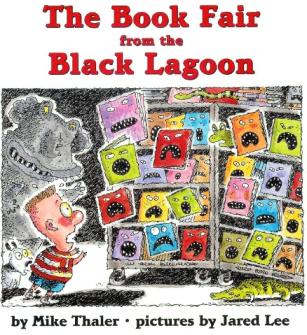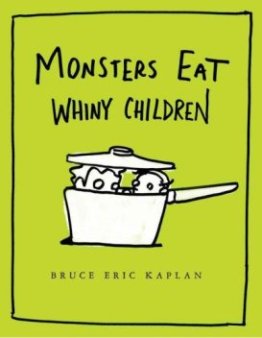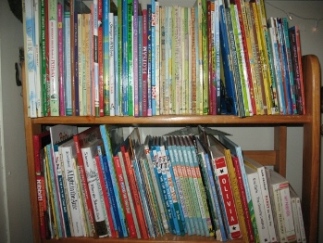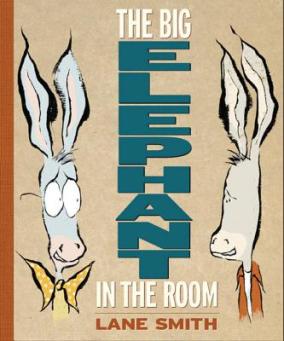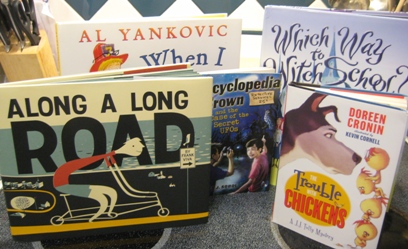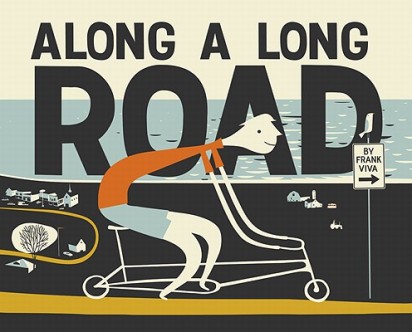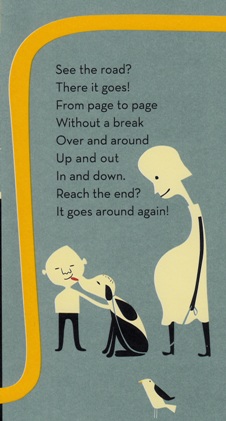Today, I have a special treat for you – the very first GUEST POST we’ve ever had at Building a Library. It was written by a dear friend, Megan McKnight, a lawyer and mom to two wonderful boys, who has been one of this blog’s biggest cheerleaders from day one. Megan actually sent me the bulk of this article in an email, asking me to give parents tips about picking titles from school book order catalogs. Her email was so full of her own great advice regarding book orders that I wrote her back and said, “Um, can I just post your email as an article? I’m never going to write anything better than what you just wrote.” And, after bugging her enough, she finally let me publish it (with a few edits and additions from her end). I love this article and think it’s a fantastic resource for any parent struggling with their monthly book order selections. Take it away, Megan!
*****
By Megan McKnight — I am a huge Building a Library fan. It is a great resource and stokes my enjoyment of reading children’s books. However, Building a Library does not help much with one of those familiar rites of the school year: BOOK ORDERS. We have been buying books from the Scholastic book order program for a few years and my track record is dubious at best. Distracted by the low prices and pretty pictures, I bought several awful books for my family. I recently recycled a stack of book order paperbacks — instead of donating them — because I do not want them to end up on another unsuspecting family’s bookshelf.
So, I developed my own set of Rules for use in ordering from the monthly book order that I follow to save my family from terrible books. Now, my family actually enjoys the books we order. My Book Order Rules are the following, in no particular order:
DO NOT BUY…
1. Books that do not list an author and illustrator. If no one has the pride to acknowledge writing or illustrating the book, it is not worth reading.
2. Books based on television, movie, or toy characters. Usually, these books are also eliminated by Rule #1. This rule is inapplicable if the book preceded the show. Olivia by Ian Falconer is a good example of this – my boys love this book!
3. Books with the exclusive purpose of teaching manners and improving behavior. Instead of making your child more patient and kind, these books will probably leave you and your child annoyed and bored. There are a few entertaining books intended to reinforce good behavior — seek these outside of the book order. For example, we enjoy these books: Do Unto Otters: A Book About Manners by Laurie Keller, Monsters Eat Whiny Children by Bruce Eric Kaplan, and Potty Animals: What to Know When You’ve Got to Go by Hope Vestergaard.
4. Book collections centered on the same character(s). For example, if you and your kids love Llama Llama Red Pajama by Anna Dewdney, you do not need three more Llama books. Chances are that you will get Llama-ed out, very quickly, and it may sap some of the magic from that first book, too. Instead, use the book order as a chance to expand your horizons. However, see Rule #12 below for a very important exception.
5. Books accompanied by a CD or DVD. The usual running time is 3 1/2 minutes per book, which is hardly worth the trouble of getting it set-up. Just sit down and read to your child for three minutes.
6. Books in hardcover. These are usually more than $10, and it is not worth paying more than $10 for any book from the book order, given the remote likelihood that the books will impress both you and your kid. If the book is good, it will be published in paperback soon..
7. Book collections that are exclusively seasonal. For example, “Books About Fall” or “Books About Easter.” For some reason, these are generally terrible and you will have squandered another opportunity to read an amazing story.
8. Non-books like games, shoe-tying activities, puzzles, toys and chore-charts. I have bought them all and the quality is universally poor.
9. Books that are accompanied by an accessory such as a car, a rock, a necklace, or 3-D glasses. The accessory is always of poor quality and the book rarely stands on its own. [read the rest of the post…]
{ 14 comments }
